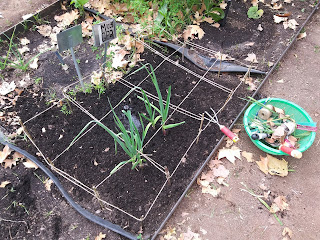Research Proposal
Hey fellow bloggers!
This week I worked on my research proposal. When I saw the assignment my initial reaction was "How do I....", but after reading through the assignment and talking with my mentor Dr. Ortiz I was able to put together a rough draft and then went from there. Here I present to you my research proposal, let me know what you think! (Also, there is a picture of the PC garden at the bottom of the proposal because, why not?)
Do your best whenever you are doing anything!
-Chris
RESEARCH PROPOSAL
The CAP-LTER (Central Arizona–Phoenix
Long-Term Ecological Research) project
through ASU includes a long term study on ground dwelling arthropod
biodiversity in diverse locations around the greater Phoenix metropolitan area.
This study seeks to understand the impact urban development has on the
biodiversity of ground dwelling arthropods, which include insects and arachnids
among others. It is important to study arthropods because they are the base of
the food chain along with plants. Changes in arthropod biodiversity can have a
cascading effect on the biodiversity of larger animals which can make up the
secondary, tertiary, and quaternary levels of the local food chains. Phoenix
College is following the CAP-LTER protocol to study arthropod biodiversity on
two plots of land on the Phoenix College campus. One plot is an edible/flower
garden without pesticide use and the other is a mostly empty plot, with
pesticide use, that is planned for development into a native
pollinator/wildlife garden. Our research will enable us to become aware of the
current biodiversity of the arthropod communities, in both plots, before the
native pollinator/wildlife garden is developed, and to see how those
communities, in both plots, change in response to the development of the
garden.
We will be
collecting garden arthropods for observation using a technique called pitfall
trapping. The trap is a simple setup consisting of a hole in the ground, and a
plastic cup that fits into a PVC tube which is then placed into the hole. The
trap is set level to the ground so that the arthropods, unaware of the hole,
fall into it for collection. Our project will first undergo a trial run in our
edible/flower garden, to make sure that the traps work, and then it will be
rolled out to also include the future site of the pollinator/wildlife garden.
We will be cataloging the arthropods by number of orders and possibly into
number of morpho-species depending on if species of an order can be
differentiated visibly.
|
GROUND DWELLING ARTHROPOD VARIABLE TABLE
|
||||
|
NAME
|
I/D/C
|
SYMBOL
|
UNITS
|
DESCRIPTION
|
|
Plant
Biodiversity
|
I
|
#P
|
# of species
|
Plant species present during
observation.
|
|
Plant
Cover vs
Bare
Area
|
I
|
PC% / BA%
|
%
|
Percentage of area covered by
plants.
|
|
Location
|
I
|
Latitude / Longitude
|
Coordinates
|
Latitude and Longitude of specific
garden plots.
|
|
Length
of time studied
|
C
|
Week/Day
|
Week/Day
|
Timeframe that specimens were
trapped and observed.
|
|
Arthropod
Biodiversity (Number of specimens)
|
D
|
#AS
|
# of
|
Arthropod specimens catalogued
during observation.
|
|
Arthropod
Biodiversity (Number of orders
represented)
|
D
|
#AO
|
Number of orders / Number of
morpho-species
|
Arthropod order/morpho-species
catalogued during observation.
|
This project is long-term and seeks to understand how
landscape changes affect the local arthropod biodiversity. Because the native
pollinator/wildlife garden will not be developed until after the 2020 spring
semester, our short-term question is looking to compare the difference of
arthropod biodiversity in our edible/flower garden versus our future native
pollinator/wildlife garden site. We expect to see a greater biodiversity and
number of species in our edible/flower garden versus the undeveloped native pollinator/wildlife
garden due in part to the number of plants currently present in each location
and because of the water availability between the two areas. I expect that we
will find major differences in the arthropod orders that will be catalogued
between both areas. Due to available resources, the undeveloped area may have a
more homogeneous community of arthropods whereas the edible/flower garden may
be more heterogeneous.
Sources
·
Bang,
Christofer, and Stanley H. Faeth. “Variation in Arthropod Communities in
Response to Urbanization: Seven Years of Arthropod Monitoring in a Desert
City.” Landscape and Urban Planning, Elsevier, 5 Oct. 2011,
www.sciencedirect.com/science/article/pii/S0169204611002647?via=ihub.
·
Hancock,
M. H., & Legg, C. J. (2011). Pitfall trapping bias and arthropod body mass.
Insect Conservation and Diversity, 5(4), 312–318. doi:
10.1111/j.1752-4598.2011.00162.x
· Lagucki, E., Burdine, J. D., & McCluney, K. E. (2017).
Urbanization alters communities of flying arthropods in parks and gardens of a
medium-sized city. PeerJ, 5, e3620. Retrieved
from https://link-gale-com.ezproxy.pc.maricopa.edu/apps/doc/A503257872/AONE?u=mcc_phoe&sid=AONE&xid=4a30190a
·
Larson, K.
L., Hoffman, J., & Ripplinger, J. (2017, September). Legacy effects and
landscape choices in a desert city. Retrieved February 9, 2020, from https://doi.org/10.1016/j.landurbplan.2017.04.014
·
Sattler,
Thomas, et al. “Urban Arthropod Communities: Added Value or Just a Blend of
Surrounding Biodiversity?” Landscape
and Urban Planning,
Elsevier, 22 Sept. 2011, www.sciencedirect.com/science/article/pii/S0169204611002593.
Edible/flower garden at PC


Comments
Post a Comment